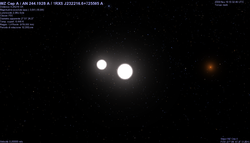| This article needs additional citations for verification. Please help improve this article by adding citations to reliable sources. Unsourced material may be challenged and removed. Find sources: "WZ Cephei" – news · newspapers · books · scholar · JSTOR (February 2018) (Learn how and when to remove this message) |
 Celestia 1.6.1's impression of WZ Cephei, eclipsing binary of W UMa-type. | |
| Observation data Epoch J2000 Equinox J2000 | |
|---|---|
| Constellation | Cepheus |
| Right ascension | 23 22 24.215 |
| Declination | +72° 54′ 56.70″ |
| Apparent magnitude (V) | +11.22 |
| Characteristics | |
| Spectral type | F5V+F5V |
| Variable type | W Ursae Majoris-type |
| Astrometry | |
| Distance | 880.2 ly (270 pc) |
| Details | |
| Mass | 1.1/0.83 M☉ |
| Radius | 1.4/0.82 R☉ |
| Luminosity | 3/1 L☉ |
| Temperature | 6400 K |
| Orbit | |
| Period (P) | 0.00114 yr |
| Semi-major axis (a) | 0.013 AU |
| Eccentricity (e) | 0.0 |
| Inclination (i) | 86.2° |
| Other designations | |
| WZ Cep, 2MASS J23222421+7254566, 1RXS J232216.6+725505 | |
| Database references | |
| SIMBAD | data |
WZ Cephei is an eclipsing binary star of W Ursae Majoris-type in the constellation of Cepheus, located 880 light years away from the Sun. The stars orbit around a common orbital barycenter every 0.41744 days (slightly over 10 hours). Timing analyses have revealed the possible presence of a third low-mass stellar companion in a wide orbit.

Presence of a third body
According to Zhu & Qian (2009) a third low-mass object of stellar nature could be responsible of orbital period variations observed for WZ Cep with a periodicity of roughly 32 years. Such a companion would yield a minimum mass of 0.17 Solar masses and be located 26.6 Astronomical Units (nearly the same orbital separation of Neptune in Solar System) from the eclipsing binary. The star could likely turn out a Proxima Centauri-analog, with inferred luminosity 3.7 percent that of Sun and 20 percent of its radius, according to mass-radius relationship.
References
- Geske; Gettel, S. J.; McKay, T. A. (2006). "A ROSAT Survey of Contact Binary Stars". The Astronomical Journal. 131 (1): 633–637. arXiv:astro-ph/0509820. Bibcode:2006AJ....131..633G. doi:10.1086/498018. S2CID 7756046.
- Djurasevic; Zakirov, M.; Hojaev, A.; Arzumanyants, G. (1998). "Analysis of the activity of the eclipsing binary WZ Cephei". Astronomy and Astrophysics Supplement. 131 (1): 17–23. Bibcode:1998A&AS..131...17D. doi:10.1051/aas:1998248.
- ^ Zhu & Qian (2009). "WZ Cephei: A Close Binary at the Beginning of Contact Phase". The Astronomical Journal. 138 (6): 2002–2006. Bibcode:2009AJ....138.2002Z. doi:10.1088/0004-6256/138/6/2002.
- "MAST: Barbara A. Mikulski Archive for Space Telescopes". Space Telescope Science Institute. Retrieved 8 December 2021.
| Constellation of Cepheus | |||||||||||||
|---|---|---|---|---|---|---|---|---|---|---|---|---|---|
| Stars |
| ||||||||||||
| |||||||||||||
| Star clusters |
| ||||||||||||
| Nebulae |
| ||||||||||||
| Galaxies |
| ||||||||||||
This variable star–related article is a stub. You can help Misplaced Pages by expanding it. |
This binary or multiple star system–related article is a stub. You can help Misplaced Pages by expanding it. |